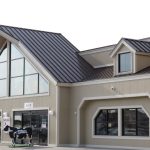The installation of big, heavy, and expensive equipment into any building requires vision, creativity, and a unique solution.
Workers will need access to the equipment for repair and maintenance, and architects will need to consider replacement of the component in building design. Whether it is a product for water management, a heating or cooling unit, or a medical device, in many instances, the only way to install a multi-ton (and essential) piece of equipment is through the roof.
That was the challenge Ochsner Health faced as it celebrated its grand reopening in September 2020 of the Gayle and Tom Benson Cancer Center at Ochsner Medical Center in New Orleans, La. Ochsner completed a $560-million renovation covering 10,683.8 m2 (115,000 sf) that year, and then renovated another 836 m2 (9,000 sf) in 2023 to establish a radiation oncology unit.
Delivering the centerpiece to the radiation suite, however, was like fitting a square peg into a round hole.
Gamma Knife delivery
Architects faced the challenge of installing a multi-ton Gamma Knife into the new oncology suite in the renovation plans. A Gamma Knife can weigh anywhere between 13.6 and
27.2 tonnes (15 and 30 tons). It uses radiation and computer-guided planning to treat brain tumors, vascular malformations, and other abnormalities in the brain.
Introduced in 1967, a Gamma Knife delivers beams of highly focused radiation, which is precisely focused on the targeted area of the brain. Tissue that surrounds the tumor or lesion is spared. Around 60,000 patients per year are treated with a Gamma Knife.1
Besides its sheer size—the units can weigh up to 27,215.5 kg (60,000 lb)—a Gamma Knife also requires frequent maintenance. The radiation source is cobalt-60, which has a half-life of 5.27 years. The hospital will need to replace 10 percent of the source annually to maintain its productivity.
For installation, workers hooked the Gamma Knife to a crane, and the operator carefully picked up the unit and lowered it inside the building through a roof hatch.
No ordinary hatch
However, this was no ordinary roof hatch. The contractor for the renovation installed a customized 3.6 x 2.7 m (12 x 9 ft) hatch from a manufacturer of specialty access products for the Ochsner project.
“We needed a customized hatch solution for the size of the opening,” according to the contractor. “It really fit the bill and was able to accommodate the varying sizes that we looked at. The size of the hatch grew in design as we completed the design phase.”
While roof hatches are common on many construction projects, the sheer size of this hatch made it extraordinary. Few U.S. manufacturers can deliver customized solutions, especially a hatch that is quite large.
The hatch in question is a steel roof hatch with 14-gauge galvannealed steel. It includes heavy-duty pintle hinges with type 316 stainless steel hinge pins, and all hardware is zinc plated or chromate sealed. However, it was a concern in this application, as there was a costly piece of lifesaving equipment located directly underneath.
The hatches are engineered with compression spring operators to provide smooth, easy one-hand operation regardless of size, and automatic hold open arms lock the covers in the open position. They are manufactured with corrosion-resistant materials and can be custom fabricated to meet virtually any access requirement. The units feature heavy gauge construction and a positive two-point latching mechanism to maintain building security and are fully insulated and gasketed for energy efficiency.
There were a lot of challenges in the project, according to the contractor. “The building dates to the 1940s and 1950s. There were a lot of unforeseen conditions, such as old plumbing and terra cotta walls. We had to cut the [metal] roof out so we could get the Gamma Knife installed. That was one of the harder things we had to do on this project, but we found a good solution.”
Combating cancer
The new cancer center is much needed in New Orleans. Louisiana ranks third in the United States with 490 new cancer cases per
100,000 residents, according to statistics from World Population Review.2 The cancer scourge is especially prevalent in one 136.8-km (85-mile) stretch along the Mississippi River that extends between Baton Rouge and New Orleans. One community in that region, Reserve, has a cancer risk that is about 50 times the national average, according to the Environmental Protection Agency.3
“The newly expanded Gayle and Tom Benson Cancer Center offers more than just much needed extra space,” says Brian Moore, MD, FACS, medical director of the Ochsner Cancer Institute. “It reinforces Ochsner’s commitment to collaborative, patient-centered care using the latest technology, innovative treatments, and a holistic approach.”
Notes
1 See https://doctorbovis.com/gamma-knife-cyberknife-radiosurgery
2 See https://worldpopulationreview.com/state-rankings/cancer-rates-by-state
3 See https://www.cbsnews.com/news/cancer-alley-reserve-louisiana-denka-plant-health-risk-higher-national-average-2019-07-24
Thomas Renner writes on building, construction, and other trade industry topics for publications throughout the United States.





